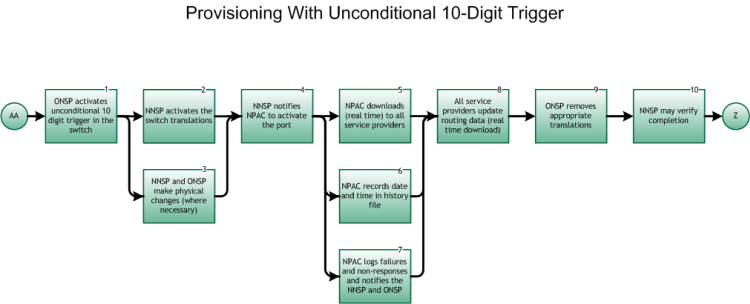Step 1: ONSP activates unconditional 10 digit trigger in the switch
- This is the entry point from the Inter-Service Provider LNP Operations Flows – Main Porting Flow, tie point AA, Figure 6.
- For both Simple and Non-Simple Ports, the wireline ONSP must deploy the 10-digit trigger in the donor switch, if technically feasible, or monitor the NPAC for activation in order to trigger the disconnect, or carriers perform a database query for every call origination.A 10-digit trigger is applied by the ONSP no later than 11:59pm the day prior to the due date.
- The unconditional 10-digit trigger may optionally be applied by the NNSP.
Please note, Steps 2 and 3 MAY be worked concurrently.
Step 2: NNSP activates switch translations
- The NNSP activates its own switch translations.
Step 3: NNSP and ONSP make physical changes (where necessary)
- Any physical work or changes are made by either NNSP or ONSP, as necessary.
- Physical changes may or may not be coordinated. Coordinated physical changes are based on inter-connection agreements between the involved service providers.
- The NNSP is now providing dial-tone to ported in user
Step 4: NNSP notifies NPAC to activate the port
- The NNSP sends an activate message via the SOA interface to the NPAC.
- No NPAC SV may activate before the FOC due date/time. Unless otherwise agreed to between both porting parties (ONSP and NNSP) the SV Due Date is the FOC due date agreed upon between the ONSP and NNSP.
Please note, Steps 5, 6, and 7 may be concurrent, but, at a minimum, should be completed ASAP.
Step 5: NPAC downloads (real time) to all service providers
- The NPAC broadcasts new SV data to all SPs in the serving area in accordance with the NANC FRS and NANC IIS. The Service Control Point (SCP) Applications and GTT Function for Number Portability requirements are defined by T1S1.6.
Step 6: NPAC records date and time in history file
- The NPAC records the current date and time as the Activation Date and Time stamp, at the start of the broadcast. The Activation Complete Timestamp is based on the first LSMS that successfully acknowledged receipt of new subscription version.
Step 7: NPAC logs failures and non-responses and notifies the NNSP and ONSP
- The NPAC resends the activation to a Local SMS that did not acknowledge receipt of the request, based on the retry tunable and retry interval. The number of NPAC attempts to send is a tunable parameter for which the current setting is one (1) attempt, in which case no retry attempts are performed. Once this cycle is completed NPAC personnel, when requested, investigate possible problems. In addition, the NPAC sends a Notification via the SOA interface to both the NNSP and ONSP with a list of LSMSs that failed activation.
Step 8: All service providers update routing data (real time download)
- This is an internal process and is performed in accordance with the Service Control Point (SCP) Applications and GTT Function for Number Portability requirements as defined by ATIS T1S1.6 (within 15 minutes).
Step 9: ONSP removes appropriate translations
- After update of its databases the ONSP removes translations associated with the ported TN(s). The removal of these translations (1.) will not be done until the old Service Provider has evidence that the port has occurred, or (2.) will not be scheduled earlier than 11:59 PM one day after the due date, or (3.) will be scheduled for 11:59 PM on the due date, but can be changed by an LSR supplement received no later than 9:00 PM local time on the due date. This LSR supplement must be submitted in accordance with local practices governing LSR exchange, including such communications by telephone, fax, etc.
- It is necessary for the OLSP to terminate the End User’s service for the ported TN(s) after the port is completed.
Step 10: NNSP may verify completion
- The NNSP may make test calls to verify that calls to ported numbers complete as expected.
Step 11: End

